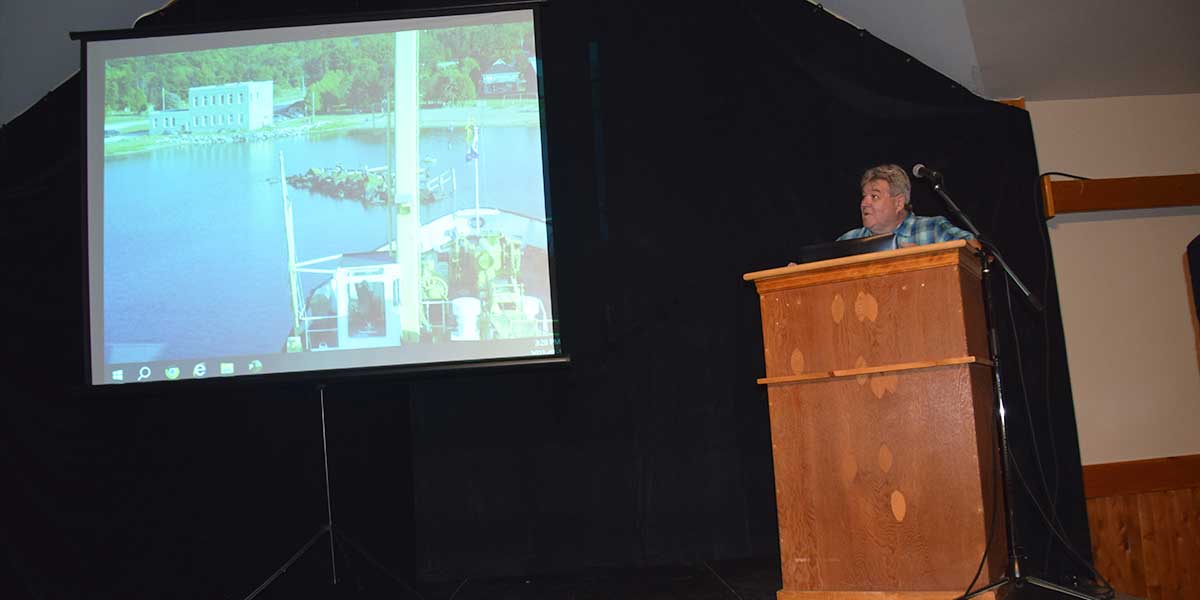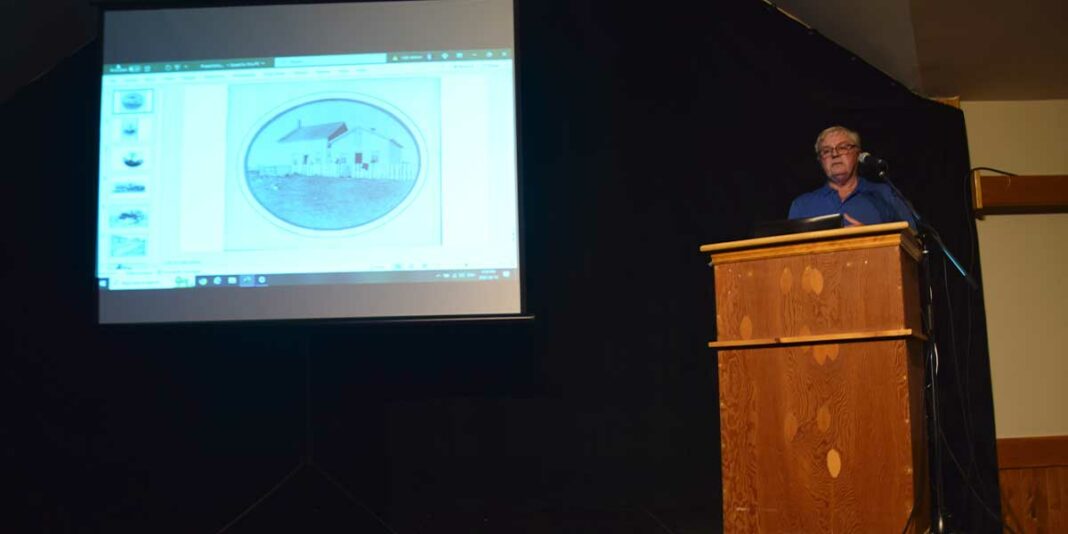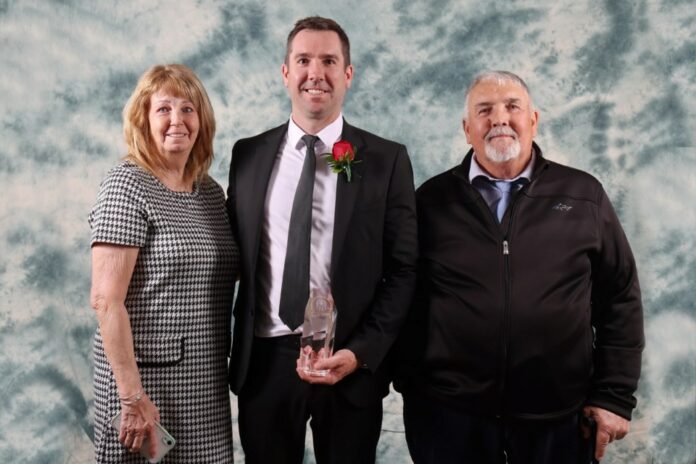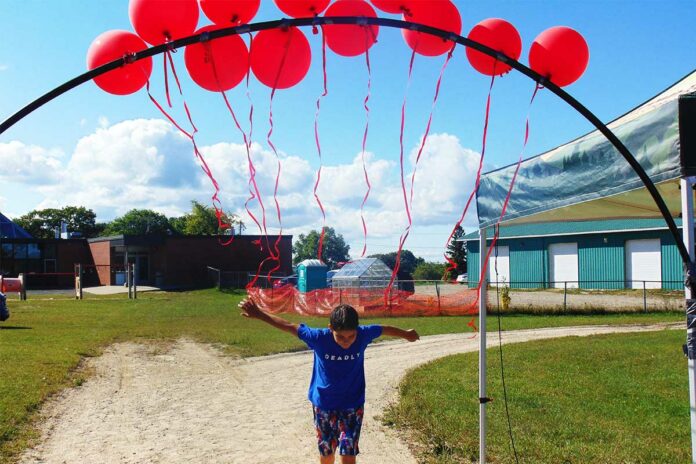KAGAWONG—History Day in Kagawong is one of the seminal educational events of the summer on Manitoulin Island, as Old Mill Heritage Centre curator Rick Nelson and the museum committee present topics of historical interest as a late summer diversion at the Kagawong Park Centre.
This year, the two presentations (a matinee at 3:30 and evening presentation at 7 pm) focussed on the coming of the railroad and telegraph (soon to be telephone) to Manitoulin, delivered by Island mercantile scion Jib Turner, whose family played a key role in bringing both to the Island, and a second act comprising a reprise of Mr. Nelson’s lifelong passion for the events surrounding the assassination of American President John F. Kennedy, an act that reverberated around the world.
In addition to the presentations, a display of magazines and newspapers from the era of the Kennedy assassination were on display, including an 8mm film camera similar to the one that captured the assassination and was viewed around the world. This year, the OId Mill Heritage Centre’s featured exhibit is an amazing collection of old photography equipment.
Mr. Turner accompanied his presentation with a slideshow of photographs of his ancestor, Byron Turner and his partner in all things rail and telegraph, K.B. Kilganon. While the Turner patriarch was a prominent merchant on Manitoulin, Mr. Kilganon was an 18-year-old engineer whose early work formed the eventual basis of a good portion of the Trans Canada Highway.
Mr. Turner laid out the backdrop to the times, noting that most traffic to Manitoulin in the latter part of the 19th Century was waterborne, therefore leaving the Island largely cut off from the outside world for much of the year. This had grave economic and health implications for those living, farming and timbering, on Manitoulin.
“It was very dangerous to travel the Lake Huron waters to the south of Manitoulin Island,” noted Mr. Turner. “There were violent storms and no navigational knowledge to speak of.”
Mr. Kilganon, of Catholic Irish immigrant stock, was raised in Quebec and attended Laval University. He came to Little Current to supervise dredging for the federal government in order to open up the North Channel as a safer east/west route for shipping than Lake Huron. After this contract was complete, “he had very little business to attend to, so he was engaged by my great grandfather to construct a railroad charter,” said Mr. Turner. As a prominent local Conservative and businessperson, he explained, Byron Turner knew the ins and outs of the political world of the time and the pair had soon acquired a charter running from McKerrow in the north to Manitoulin in the south. Thus was born the Manitoulin and North Shore Railway.
But railroads are expensive propositions at the best of times, and it fell to American industrialist Francis Clergue and his Algoma Central Railway running from Sault Ste. Marie to complete the job—the name of the spur to Manitoulin changing to the Algoma Eastern Railway. In 1930, with the depression taking its toll on investment, the lines were acquired by the deeper-pocketed Canadian Pacific Railway. Unfortunately, the original vision of the rail lines extending across Manitoulin Island were not to be realized, but still, the impact of the railway and the building of the iconic swing bridge at Little Current were to radically change life on Manitoulin.
Mr. Turner went on to describe how the telegraph came to the Island, such modern contraptions going hand-in-hand with rail lines. Eventually, that morphed into a telephone exchange. The three telephones located in the upstairs of Turners of Little Current were always busy. In those days before cell phones and email, the telegraph and later telephone service were vital to wealthy American industrialist who came by rail and ship for fishing vacations on Manitoulin.
Mr. Turner touched on the important role King Coal played in the development of the Port of Little Current and the coal docks on Goat Island across from the town, as well as the role played by iron ore pellets when coal began to be replaced after the Second World War.
Following Mr. Turner’s presentation, and a short intermission with light refreshments, Mr. Nelson took the audience through his lifelong interactions with people and places surrounding the JFK assassination.
Mr. Nelson shared that he does believe that Lee Harvey Oswald shot the president, although he left the jury out on whether the assassin had help or other assailants. In addition to a number of film and photographs from the event (including one that required a trigger warning given that it was the moment the bullet entered the president’s head), Mr. Nelson shared his on the ground explorations of where the event took place and his many conversations with notable individuals who were witness to the events. Those included Mr. Oswald’s widow and the man who was handcuffed to Mr. Oswald when he was, in turn, murdered by Jack Ruby.

The official history is that Mr. Oswald shot and killed President Kennedy on November 22, 1963, shooting from a sixth-floor window of the Texas School Book Depository as the president travelled by motorcade through Dealey Plaza in Dallas. About 45 minutes after assassinating Kennedy, Mr. Oswald shot and killed Dallas police officer J.D. Tippit on a local street. He then slipped into a movie theatre where he was arrested for Tippits murder. Mr. Oswald was charged with the assassination of President Kennedy, but steadfastly denied responsibility for the killing, claiming that he was a patsy—a version held by his widow for many years. Two days later, Mr. Oswald was fatally shot by a local nightclub owner, Jack Ruby, on live television in the basement of Dallas Police Headquarters.
Mr. Nelson proved himself during the presentation as being among the foremost experts on the Kennedy assassination, the result, no doubt, of his self-admitted lifelong fascination and passion for all things surrounding that historic event. He even set up a conference in Sudbury on the 30th anniversary of the assassination which attracted many of the key witnesses and players in the event and was brought down to Texas to assist in moving the museum focussed on the assassination.
History Day in Kagawong 2023 upheld the tradition of providing unparalleled historical educational opportunities on Manitoulin Island, be it local, national or international.





